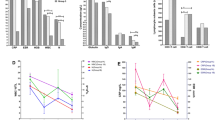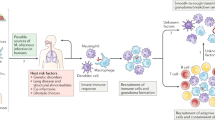Abstract
Patients undergoing bone marrow transplantation are profoundly immunosuppressed as a result of their intensive myeloablative chemotherapy and are at high risk for opportunistic fungal infections mainly caused by Candida spp and Aspergillus spp. Trichosporon beigelii (T beigelii) has emerged as a life-threatening opportunistic pathogen in granulocytopenic and immunocompromised hosts and there is a marked increase in cases reported in the literature. Response to antifungal agents is poor, mortality is high and immunological recovery is the most important factor for a favorable outcome in patients with trichosporonosis. We present three cases of T. beigelii infection in patients undergoing allogeneic bone marrow transplantation in our center and we review cases described in the literature. Bone Marrow Transplantation (2000) 25, 745–749.
This is a preview of subscription content, access via your institution
Access options
Subscribe to this journal
Receive 12 print issues and online access
$259.00 per year
only $21.58 per issue
Buy this article
- Purchase on Springer Link
- Instant access to full article PDF
Prices may be subject to local taxes which are calculated during checkout
Similar content being viewed by others
References
Rippon JW . Superficial infections. In: Rippon JW (ed) Medical Mycology 2nd edn: WB Saunders: Philadelphia 1979 pp 148–151
Hoy J, Hsu KC, Rolston K et al. Trichosporon beigelii infection: a review Rev Infect Dis 1986 8: 959–967
Yoss BS, Sautter RL, Brenker HJ . Trichosporon beigelii, a new neonatal pathogen Am J Perinatol 1997 14: 113–117
Keay S, Denning DW, Stevens DA . Endocarditis due to Trichosporon beigelii: in vitro susceptibility of isolates and review Rev Infect Dis 1991 13: 383–386
Brahn E, Leonard PA . Trichosporon cutaneum endocarditis: a sequela of intravenous drug-abuse Am J Clin Path 1982 78: 792–794
Ashpole RD, Jacobson K, King AT, Holmes AE . Cysto-peritoneal shunt infection with Trichosporon beigelii Br JNeurosurg 1991 5: 515–517
Muramatsu H, Kume H, Hojo M et al. A case of Trichosporon beigelii peritonitis in CAPD Kansenshogaku Zasshi 1992 66: 1129–1132
Mathews MS, Prabhakar S . Chronic meningitis caused by Trichosporon beigelii in India Mycoses 1995 38: 125–126
Bottari M, D'Amore F, Buda CA et al. Stenosing esophagitis caused by Trichosporon beigelii: presentation of a rare case G Chir 1997 18: 344–347
Sheikh HA, Mahgoub S, Badi K . Postoperative endophthalmitis due to Trichosporon cutaneum Br J Ophthalmol 1974 58: 591–594
Gardella S, Nomdedeu B, Bombi JA et al. Fatal fungemia with arthritic involvement caused by Trichosporon beigelii in a bone marrow transplant recipient J Infect Dis 1985 151: 566
Patel SA, Borges MC, Batt MD, Rosenblate JH . Trichosporon cholangitis associated with hyperbilirubinemia and findings suggesting primary sclerosing cholangitis on endoscopic retrograde cholangiopancreatography Am J Gastroenterol 1990 85: 84–87
Korinek JK, Guarda LA, Bolivar R, Stroehlein JR . Trichosporon hepatitis Gastroenterology 1983 85: 732–734
Nishiura Y, Nakagawa-Yoshida K, Suga M et al. Assignment and serotyping of Trichosporon species: the causative agents of summer-type hypersensitivity pneumonitis J Med Vet Mycol 1997 35: 45–52
McBride ME, Kalter DC, Wolf JE Jr . Antifungal susceptibility testing of Trichosporon beigelii to imidazole compounds Can J Microbiol 1988 34: 850–854
Walsh TJ, Melcher GP, Rinaldi MG et al. Trichosporon beigelii, an emerging pathogen resistant to amphotericin B J Clin Microbiol 1990 28: 1612–1622
Nasu K, Akuzuki S, Yoshiyama K et al. Disseminated Trichosporon infection. A case report and immunohistochemical study Arch Pathol Lab Med 1994 118: 191–194
Muranaka H, Suga M, Nakagawa K et al. Effects of granulocyte and granuloyte–macrophage colony-stimulating factors in a neutropenic murine model of trichosporonosis Infect Immun 1997 65: 3422–3429
Lucarelli G, Galimberti M, Polchi P et al. Bone marrow transplantation in patients with thalassemia New Engl J Med 1990 322: 417–421
Goodman JL, Winston DJ, Greenfield RA et al. A controlled trial of fluconazole to prevent fungal infections in patients undergoing bone marrow transplantation New Engl J Med 1992 326: 845–851
Slavin MA, Osborne B, Adams R et al. Efficacy and safety of fluconazole prophylaxis for fungal infections after marrow transplantation – a prospective, randomized, double-blind study J Infect Dis 1995 171: 1545–1552
Ellis ME, Clink H, Ernst P et al. Controlled study of fluconazole in the prevention of fungal infections in neutropenic patients with haematological malignancies and bone marrow transplant recipients Eur J Clin Microbiol Infect Dis 1994 13: 3–11
O'Donnell MR, Schmidt GM, Tegtmeier BR et al. Prediction of systemic fungal infection in allogeneic marrow recipients. Impact of amphotericin prophylaxis in high-risk patients J Clin Oncol 1994 12: 827–834
Jesse L, Goodman MD, Drew J et al. A controlled trial of fluconazole to prevent fungal infections in patients undergoing bone marrow transplantation New Engl J Med 1992 326: 845–851
Perfect JR, Schell WA . The new fungal opportunists are coming Clin Infect Dis 1996 22: (Suppl. 2) S112–S118
Watson KC, Kallichurum S . Brain abscess due to Trichosporon cutaneum J Med Microbiol 1970 3: 191–193
Martinez LJ, Mana J, Niubo R et al. Long-term survival of a patient with prosthetic valve endocarditis due to Trichosporon beigelii Eur J Clin Microbiol Infect Dis 1991 10: 756–758
Reinhart HH, Urbanski DM, Harrington SD, Sobel JD . Prosthetic valve endocarditis caused by Trichosporon beigelii Am J Med 1988 84: 355–358
McManus EJ, Jones JM . Detection of a Trichosporon beigelii antigen cross-reactive with Cryptococcus neoformans capsular polysaccharide in serum from a patient with disseminated Trichosporon infection J Clin Microbiol 1985 21: 681–685
McManus EJ, Bozdech MJ, Jones JM . Role of the latex agglutination test for cryptococcal antigen in diagnosing disseminated infections with Trichosporon beigelii J Infect Dis 1985 151: 1167–1169
Melcher GP, Reed KD, Rinaldi MG et al. Demonstration of a cell wall antigen cross-reacting with cryptococcal polysaccharide in experimental disseminated trichosporonosis J Clin Microbiol 1991 29: 192–196
Anaissie E, Gokaslan A, Hachem R et al. Azole therapy for trichosporonosis: clinical evaluation of eight patients, experimental therapy of murine infection, and review Clin Infect Dis 1992 15: 781–787
Perparim K, Nagai H, Hashimoto A et al. In vitro susceptibility of Trichosporon beigelii to antifungal agents J Chemother 1996 8: 445–448
Espinel Ingroff A . In vitro activity of the new triazole voriconazole (UK-109,496) against opportunistic filamentous and dimorphic fungi and common and emerging yeast pathogens J Clin Microbiol 1988 36: 198–202
Sutton DA, Sanche SE, Revankar SG et al. In vitro amphotericin B resistance in clinical isolates of Aspergillus terreus, with a head–head comparison to voriconazole J Clin Microbiol 1999 37: 2343–2345
Marco F, Pfaller MA, Messer SA, Jones RN . Antifungal activity of a new triazole, voriconazole (UK-109,496), compared with three other antifungal agents against clinical isolates of filamentous fungi Med Mycol 1998 36: 433–436
Wildfeuer A, Seidl HP, Paole I, Haberreiter A . In vitro evaluation of voriconazole against clinical isolates of yeasts, moulds and dermatophytes in comparison with itraconazole, ketoconazole, amphotericin B and griseofulvin Mycoses 1998 41: 309–319
Acknowledgements
The authors thank Ms Aileen Law, a member of our nursing staff, for excellent assistance.
Author information
Authors and Affiliations
Rights and permissions
About this article
Cite this article
Erer, B., Galimberti, M., Lucarelli, G. et al. Trichosporon beigelii: a life-threatening pathogen in immunocompromised hosts. Bone Marrow Transplant 25, 745–749 (2000). https://doi.org/10.1038/sj.bmt.1702231
Received:
Accepted:
Published:
Issue Date:
DOI: https://doi.org/10.1038/sj.bmt.1702231
Keywords
This article is cited by
-
Isolation of Hexavalent chromium tolerant fungal species from urban vegetable farm soil and effluent waste in Addis Ababa& Rift valley, Ethiopia
World Journal of Microbiology and Biotechnology (2023)
-
Progress in Definition, Prevention and Treatment of Fungal Infections in Cystic Fibrosis
Mycopathologia (2018)
-
Voriconazole for both successful treatment of disseminated Trichosporon asahii infection and subsequent cord blood transplantation in an infant with acute myelogenous leukemia
Bone Marrow Transplantation (2011)
-
Supplemental utility of nested PCR for the pathological diagnosis of disseminated trichosporonosis
Virchows Archiv (2007)



